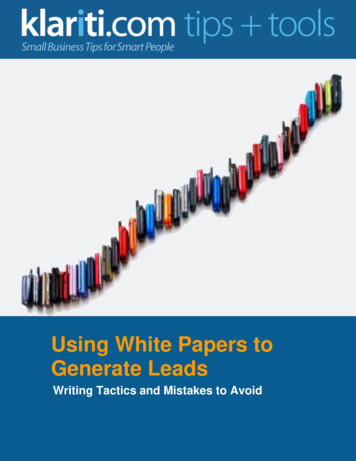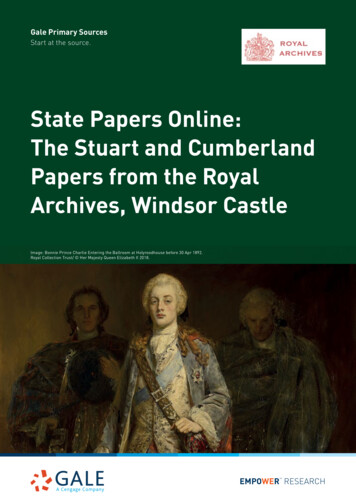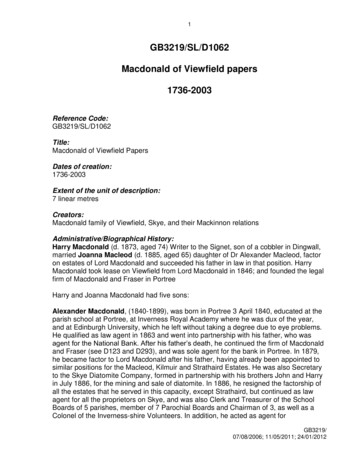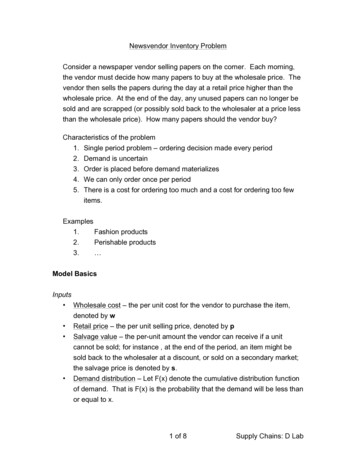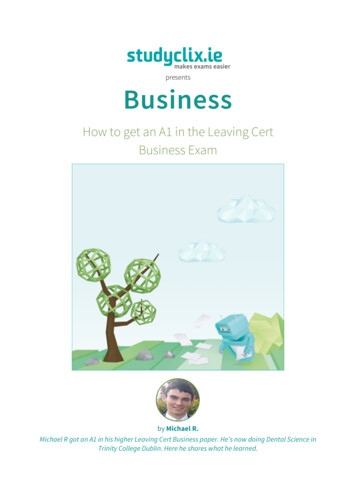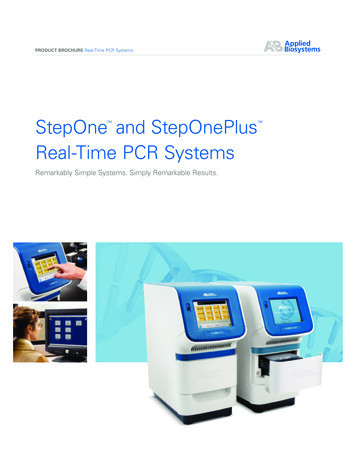
Transcription
COVID ECONOMICSVETTED AND REAL-TIME PAPERSISSUE 617 APRIL 2020ECONOMIC INDEXDaniel Lewis, Karel Mertens andJames StockHEALTH VS WEALTHHOME WORKING INDEVELOPING COUNTRIESFernando SaltielAndrew Glover, Jonathan Heathcote,Dirk Krueger and José-Víctor Ríos-RullRISK UNDERESTIMATIONSUPPLY AND DEMAND1918 FLU IN DENMARKR. Maria del Rio-Chanona,Penny Mealy, Anton Pichler,Francois Lafond and J. Doyne FarmerChristian MØller Dahl,Casper Worm Hansen andPeter Sandholt JensenJordan Schoenfeld
Covid EconomicsVetted and Real-Time PapersCovid Economics, Vetted and Real-Time Papers, from CEPR, brings togetherformal investigations on the economic issues emanating from the Covidoutbreak, based on explicit theory and/or empirical evidence, to improve theknowledge base.Founder: Beatrice Weder di Mauro, President of CEPREditor: Charles Wyplosz, Graduate Institute Geneva and CEPRContact: Submissions should be made at -real-time-journal-cej. Other queries should be sent tocovidecon@cepr.org. CEPR Press, 2020The Centre for Economic Policy Research (CEPR)The Centre for Economic Policy Research (CEPR) is a network of over 1,500research economists based mostly in European universities. The Centre’s goal istwofold: to promote world-class research, and to get the policy-relevant resultsinto the hands of key decision-makers. CEPR’s guiding principle is ‘Researchexcellence with policy relevance’. A registered charity since it was founded in1983, CEPR is independent of all public and private interest groups. It takes noinstitutional stand on economic policy matters and its core funding comes fromits Institutional Members and sales of publications. Because it draws on such alarge network of researchers, its output reflects a broad spectrum of individualviewpoints as well as perspectives drawn from civil society. CEPR research mayinclude views on policy, but the Trustees of the Centre do not give prior reviewto its publications. The opinions expressed in this report are those of the authorsand not those of CEPR.Chair of the BoardFounder and Honorary PresidentPresidentVice PresidentsChief Executive OfficerSir Charlie BeanRichard PortesBeatrice Weder di MauroMaristella BotticiniUgo PanizzaPhilippe MartinHélène ReyTessa Ogden
EthicsCovid Economics will publish high quality analyses of economic aspects of the health crisis.However, the pandemic also raises a number of complex ethical issues. Economists tend tothink about trade-offs, in this case lives vs. costs, patient selection at a time of scarcity, andmore. In the spirit of academic freedom, neither the Editors of Covid Economics nor CEPRtake a stand on these issues and therefore do not bear any responsibility for views expressed inthe journal’s articles.Editorial BoardBeatrice Weder di Mauro, CEPRCharles Wyplosz, Graduate InstituteGeneva and CEPRViral V. Acharya, Stern School of Business,NYU and CEPRGuido Alfani, Bocconi University and CEPRFranklin Allen, Imperial College BusinessSchool and CEPROriana Bandiera, London School ofEconomics and CEPRDavid Bloom, Harvard T.H. Chan School ofPublic HealthTito Boeri, Bocconi University and CEPRMarkus K Brunnermeier, PrincetonUniversity and CEPRMichael C Burda, Humboldt Universitaetzu Berlin and CEPRPaola Conconi, ECARES, Universite Librede Bruxelles and CEPRGiancarlo Corsetti, University ofCambridge and CEPRMathias Dewatripont, ECARES, UniversiteLibre de Bruxelles and CEPRBarry Eichengreen, University ofCalifornia, Berkeley and CEPRSimon J Evenett, University of St Gallenand CEPRAntonio Fatás, INSEAD Singapore andCEPRFrancesco Giavazzi, Bocconi University andCEPRChristian Gollier, Toulouse School ofEconomics and CEPRRachel Griffith, IFS, University ofManchester and CEPREthan Ilzetzki, London School ofEconomics and CEPRBeata Javorcik, EBRD and CEPRSebnem Kalemli-Ozcan, University ofMaryland and CEPRTom Kompas, University of Melbourne andCEBRAPer Krusell, Stockholm University andCEPRPhilippe Martin, Sciences Po and CEPRWarwick McKibbin, ANU College of Asiaand the PacificKevin Hjortshøj O’Rourke, NYU AbuDhabi and CEPREvi Pappa, European University Instituteand CEPRBarbara Petrongolo, Queen MaryUniversity, London, LSE and CEPRRichard Portes, London Business Schooland CEPRCarol Propper, Imperial College Londonand CEPRLucrezia Reichlin, London Business Schooland CEPRRicardo Reis, London School of Economicsand CEPRHélène Rey, London Business School andCEPRDominic Rohner, University of Lausanneand CEPRMoritz Schularick, University of Bonn andCEPRPaul Seabright, Toulouse School ofEconomics and CEPRChristoph Trebesch, Christian-AlbrechtsUniversitaet zu Kiel and CEPRThierry Verdier, Paris School ofEconomics and CEPRJan C. van Ours, Erasmus UniversityRotterdam and CEPRKaren-Helene Ulltveit-Moe, University ofOslo and CEPR
Covid EconomicsVetted and Real-Time PapersIssue 6, 17 April 2020ContentsUS economic activity during the early weeks of the SARS-Cov-2 outbreakDaniel Lewis, Karel Mertens and James StockHealth versus wealth: On the distributional effects of controllinga pandemicAndrew Glover, Jonathan Heathcote, Dirk Krueger andJosé-Víctor Ríos-RullSupply and demand shocks in the COVID-19 pandemic:An industry and occupation perspectiveR. Maria del Rio-Chanona, Penny Mealy, Anton Pichler, Francois Lafondand J. Doyne Farmer12265Who can work from home in developing countries?Fernando Saltiel104The invisible risk: Pandemics and the financial marketsJordan Schoenfeld119The 1918 epidemic and a V-shaped recession: Evidence from municipalincome dataChristian MØller Dahl, Casper Worm Hansen and Peter Sandholt Jensen137
1Covid EconomicsIssue 6, 17 April 2020US economic activity during theearly weeks of the SARS-Cov-2outbreak1Covid Economics 6, 17 April 2020: 1-21Daniel Lewis,2 Karel Mertens3 and James Stock4Date submitted: 10 April 2020; Date accepted: 11 April 2020This paper describes a weekly economic index (WEI) developed totrack the rapid economic developments associated with the responseto the novel Coronavirus in the United States. The WEI shows a strongand sudden decline in economic activity starting in the week endingMarch 21, 2020. In the most recent week ending April 4, the WEIindicates economic activity has fallen further to -8.89% scaled to 4quarter growth in GDP.1234Bi-weekly updates of the Weekly Economic Index are available at https://www.jimstock.org/. The viewsexpressed are those of the authors and do not necessarily reflect the position of the Federal Reserve Bank ofNew York, the Federal Reserve Bank of Dallas or the Federal Reserve System. We are grateful to Mihir Trivediand Eric Qian for research assistance, to Tyler Atkinson for useful suggestions, and to Mark Booth for sharingthe tax collections data.Economist, Federal Reserve Bank of New York.Senior Economic Policy Advisor, Federal Reserve Bank of Dallas.Professor of Political Economy, Harvard University.COVID ECONOMICSVETTED AND REAL-TIME PAPERS
2Covid Economics 6, 17 April 2020: 1-21Economists are well-practiced at assessing real economic activity based on arange of familiar aggregate time series, such as the unemployment rate,industrial production, or GDP growth. However, these series representmonthly or quarterly averages of economic conditions, and are onlyavailable at a considerable lag, after the month or quarter ends. When theeconomy hits sudden headwinds such as the COVID-19 pandemic,conditions can evolve rapidly. How can we monitor the high-frequencyevolution of the economy in “real time”?To address this challenge, this paper develops a Weekly Economic Index(WEI) that measures real economic activity at a weekly frequency and thatcan be updated relatively quickly.2 Few of the government agency datareleases macroeconomists often work with are available at weekly or higherfrequency. Our weekly series instead come mostly from private sources suchas industry groups that collect data for the use of their members, or fromcommercial polling companies. Financial data, such as stock market pricesand interest rates, are also available at high frequency. We do not usefinancial data in the construction of the WEI, as our objective is to obtain adirect measure of real activity, and not of financial conditions.To compute our index, we extract the first principal component from 10weekly time series, using the sample from January 2008 to present. We scaleour baseline index to four-quarter GDP growth, such that a reading of 2percent in a given week means that if the week’s conditions persisted for anentire quarter, we would expect, on average, 2 percent growth relative to ayear previous.3 The top panel in Figure 1 plots the WEI based on data throughApril 9, 2020. The trough of the Great Recession is clearly visible, as well asthe subsequent recovery. The WEI index also shows a modest decline duringthe 2015-2016 mini-recession, during which the energy and agriculturalsectors as well as certain segments of the manufacturing economyexperienced substantial slowdowns in growth.The bottom panel in Figure 1 shows the evolution of the WEI from January2019 to its most recent value. As is clear from the figure, developments2The WEI builds on earlier work by Stock (2013). A preliminary version of WEI waspresented in a NY Fed blog post, see Lewis, Mertens and Stock (2020).3Specifically, the mean and standard deviation of the Weekly Economic Index havebeen adjusted so that they match the mean and standard deviation of the fourquarter growth of GDP from 2008 through the fourth quarter of 2019.COVID ECONOMICSVETTED AND REAL-TIME PAPERS
Covid Economics 6, 17 April 2020: 1-213related to the Coronavirus pandemic have led the index to fall to levels belowthose of 2008 in recent weeks. Specifically, the WEI registers a strong andsudden decline in economic activity starting in the week ending March 21,2020, falling to -3.23%. For reference, the WEI stood at 1.58 for the weekending February 29. The week ending March 21 saw an unprecedented 3.28million initial UI claims (seasonally adjusted), a sharp decline in consumerconfidence and fuel sales, and a more modest decline in steel production.There was also a countervailing surge in retail sales, as consumers took tostores to stock up on consumer staples. In the week ending March 28, theWEI fell to -6.75%. This further decline was driven by another sharp increasein unemployment insurance initial claims, which came in at 6.65 million(seasonally adjusted), far surpassing the prior week’s record-setting release.The drop was reinforced by a major decline in fuel sales in response to stayat-home orders and other restrictions, a fall in steel production, and a surgein continuing unemployment insurance claims (7.46 million seasonallyadjusted), as well as modest decreases in electricity output, rail traffic,temporary and contract employment, and consumer confidence. In the mostrecent week ending April 4, the WEI fell to -8.89%. This week’s decrease wasagain driven by initial unemployment insurance claims (6.61 millionseasonally adjusted) and sharp decreases in fuel sales and steel production,and reinforced by falls in rail traffic, electricity output, and tax withholdings,while retail sales stalled.To track the rapidly evolving economic fallout of the Coronavirus pandemic,the WEI is updated weekly every Tuesday and Thursday. The weekly updatescontain preliminary estimates for the prior week based on the available data.The latter are based on estimated historical relationships between the WEIand the series available at the time of the update. The final values of the WEIare available after two weeks.COVID ECONOMICSVETTED AND REAL-TIME PAPERS
4Covid Economics 6, 17 April 2020: 1-21Figure 1: Weekly Economic Indicator (WEI)Notes: Based on data available through April 9, 2020. The units are scaledto 4-quarter GDP growth.The rest of this paper describes the underlying weekly data series as well asthe details behind the construction of WEI. We also document the closerelationship between the WEI and widely used lower frequency indicators ofaggregate economic activity in the US, such as real GDP growth and industrialproduction.I.The Weekly Data SeriesTable 1 below lists the series we use to construct our baseline WEI. Theseinclude a measure of same-store retail sales, an index of consumersentiment, initial and continued claims for unemployment insurance, anindex of temporary and contract employment, tax collections from paycheckwithholdings, a measure of steel production, a measure of fuel sales, ameasure of railroad traffic, and a measure of electricity consumption. UnlessCOVID ECONOMICSVETTED AND REAL-TIME PAPERS
5the source already provides year-on-year growth rates, we transform allseries to represent 52-week percentage changes, which also eliminates mostseasonality in the data. Figure 2 plots all the transformed series that serve asinputs to the index.Table 1: Weekly VariablesCovid Economics 6, 17 April 2020: 1-21SeriesNativeUnitsRedbook Research:Same Store, RetailSales Average, Y/Y% Chg.NSA, Y/Y %Chg.RasmussenConsumer IndexIndexUnemploymentInsurance: ed ng IndexNSA, Jun12-06 100FederalWithholding TaxCollectionsY/Y % Chg.NotesThe index is sales-weighted, year-over-year samestore sales growth for a sample of large US generalmerchandise retailers representing about 9,000stores. By dollar value, the Index represents over80% of the "official" retail sales series collected bythe Department of Commerce.http://www.redbookresearch.com/Daily survey of 1500 American adults Sun-Thurs.Index is a 3-day moving average based on fivequestions about the current state of both theeconomy and personal finances, whether theeconomy and personal finances are getting betteror worse, and whether the economy is in arecession. https://www.rasmussenreports.com/Number of claims filed by unemployed individualsafter separation from an employer. Data collectedfrom local unemployment offices.https://oui.doleta.gov/unemploy/Number of continued claims filed by unemployedindividuals to receive benefits. Data collected fromlocal unemployment offices.https://oui.doleta.gov/unemploy/The ASA Staffing Index tracks temporary andcontract employment trends. Participants include astratified panel of small, medium, and large staffingcompanies that together provide services invirtually all sectors of the industry. They accountfor about one-third of industry sales offices.https://americanstaffing.net/Treasury receipts of income and payroll taxeswithheld from paychecks. The series is filtered fordaily volatility patterns and adjusted for tax lawchanges. https://taxtracking.com/COVID ECONOMICSVETTED AND REAL-TIME PAPERS
6Raw SteelProductionNSA,Thous. NetTonsWeekly production tonnage provided from 50% ofthe domestic producers combined with monthlyproduction data for the remainder.https://www.steel.org/industry-dataUS Fuel Sales toEnd UsersNSA, EOP,Thous.barrels/dayWeekly product supplied minus change in stock offinished gasoline and distillate fuels. This estimateswholesale gasoline diesel sales to retailers andlarge end users (e.g., UPS). Published by the U.S.Energy Information Administration in the WeeklyPetroleum Status /Covid Economics 6, 17 April 2020: 1-21U.S Railroad TrafficElectric UtilityOutputNSA,unitsNSA,GigawattHoursTotal carloads and intermodal units reported byrailroad companies to the Association of AmericanRailroads https://www.aar.org/data-center/Total output for U.S. (excluding Alaska and Hawaii)investor-owned electric companies.https://www.eei.org/As can be seen in Figure 2, some of the weekly series exhibit considerablenoise from week to week, such that gleaning broader trends from any oneseries can be difficult. The series, however, also display a clear cyclicalpattern, which suggests that they might usefully be combined into a singleindex. The WEI is computed from these ten series using the method ofprincipal component analysis. The first principal component of these tenseries provides an estimate of a signal about the economy which is commonto all variables. By construction, the Weekly Economic Index is a weightedaverage of the ten series. The mathematics of principal components analysisis summarized next.COVID ECONOMICSVETTED AND REAL-TIME PAPERS
7Covid Economics 6, 17 April 2020: 1-21Figure 2 Weekly Variables and WEICOVID ECONOMICSVETTED AND REAL-TIME PAPERS
Covid Economics 6, 17 April 2020: 1-218Notes: Based on data available through April 9, 2020. For sources, see Table1.II.Construction of the Weekly Economic Index4A leading framework for the construction of an economic index from multipletime series is the so-called dynamic factor model, developed by Geweke(1977) and Sargent and Sims (1977). The dynamic factor model posits theexistence of a small number of unobserved or latent series, called factors,which drive the co-movements of the observed economic time series.Application of dynamic factor models to estimating economic indexes rangefrom the construction of state-level indexes of economic activity (Crone andClayton-Matthews, 2005) to large-scale indexes of economic activity (forexample, the Chicago Fed National Activity Index, or CFNAI). See Stock andWatson (2016) for a review.The premise of a dynamic factor model is that a small number – in ourapplication, a single – latent factor, ft, drives the co-movements of a vectorof N time-series variables, Xt. The dynamic factor model posits that theobserved series is the sum of the dynamic effect of the common factor andan idiosyncratic disturbance, et, which arise from measurement error andfrom special features that are specific to an individual series:Xt l(L)ft et4(1)Parts of this section are adapted from the appendix in Stock (2013).COVID ECONOMICSVETTED AND REAL-TIME PAPERS
9where L is the lag operator. The elements of the N 1 vector of lagpolynomials l (L) are the dynamic factor loadings, and li(L)ft is called thecommon component of the ith series. The dynamic factor can be rewritten instatic form by stacking ft and its lags into single vector Ft, which has dimensionup to the number of lags in l(L):Xt LFt et(2)where L is a matrix with rows being the coefficients in the lag polynomialCovid Economics 6, 17 April 2020: 1-21l(L).The two primary methods for estimating the unobserved factor ft are byprincipal components and using state space methods, where the factor isestimated by the Kalman filter. Broadly speaking, early low-dimensionalapplications used parametric state-space methods and more recent highdimensional applications tend to use nonparametric principal components orvariants. We used both methods in developing the WEI, but found the resultsusing the parametric DFM to be sensitive to specification details (lags, samplelength, etc.), so principal components estimation is used in this paper.COVID ECONOMICSVETTED AND REAL-TIME PAPERS
10Table 2: PCA ResultsWeightsBaselineWeightsTrimmed (ALS)Same-Store Retail SalesConsumer ConfidenceTax CollectionsInitial ClaimsContinued ClaimsTemp StaffingSteel ProductionFuel SalesElectricity OutputRailroad .290.210.31-0.38-0.410.400.360.180.130.34Total variance explained54.4%52.7%Covid Economics 6, 17 April 2020: 1-21SeriesNotes: Estimation sample is first week of 2008 through last week of February 2020.The first column uses all observations. The second column is based on a trimmedsample in which outliers were removed. In this case, the weights are estimated usingalternating least squares, see for instance Stock and Watson (2002b).An alternative approach to using high-frequency data for real-timemonitoring (“nowcasting”) is to focus on forecasting a specific economicrelease, such as the monthly change in employment, and to construct amodel that updates those forecasts as new data comes in. The dynamicfactor model and its state space implementation is useful for this purposebecause a single model automatically adapts to new data becoming availableto estimate the variable of interest. For applications of dynamic factormodels to nowcasting, see Giannone, Reichlin and Small (2008) and Aruoba,Diebold and Scotti (2009).Table 2 provides the weights associated with the first principal component,as well as the total variance explained based on the 10 weekly seriesdescribed above. The first column provides the weights using the full sampleCOVID ECONOMICSVETTED AND REAL-TIME PAPERS
11Covid Economics 6, 17 April 2020: 1-21between the first week of January 2008 and the last week of February, 2020.The second column shows the weights over the same sample period, butafter treating outliers in the weekly series as missing observations. Removingoutliers overall has little effect on the weights, and for WEI we therefore usethe full-data weights. We find that WEI explains 54% of the overall varianceof the underlying series.RobustnessThe WEI is robust to changes in the details of its construction.Subtracting or adding individual series has little effect on the overall path;the same is true for estimating the weights on each series using only morerecent data. The left panel of Figure 3 compares our baseline index to onewith a subset of 7 variables (omitting railroad traffic, tax withholdings andcontinuing claims). The middle panel plots a version in which we omitconsumer sentiment. Both figures illustrate that the common signal is notdriven by the precise choice of series. The right panel of Figure 3 plots thebaseline WEI against a series computed with weights estimated using onlydata from 2015 onward, showing that the relationship between these serieshas been fairly constant during and after the Great Recession.COVID ECONOMICSVETTED AND REAL-TIME PAPERS
12Covid Economics 6, 17 April 2020: 1-21Figure 3: Robustness ChecksNotes: Based on data available through April 9, 2020.Real Time UpdatingThe WEI is published every Tuesday and Thursdayfollowing the releases of the underlying weekly data. Each WEI releasereports a preliminary estimate for the prior week based on the data availableat that point. The Tuesday update reflects incoming data on retail sales,consumer confidence and steel production for the prior week, as well as dataon temp staffing for the week before the prior week. The Thursday updatereflects incoming data on fuel sales, tax collections, initial claims, electricityuse, and railroad traffic for the prior week, as well as data on continuedclaims for the week before the prior week. Final values for the WEI areavailable with a two-week lag.Our procedure to produce the preliminary values is based on forecastingregressions for the WEI on two lags of WEI as well as the non-missing data.For example, in the Thursday update, where we miss the latest data pointsfor two series, we use the estimated value from the forecasting regression ofthe WEI on its lags and the current values of the eight available series. TheCOVID ECONOMICSVETTED AND REAL-TIME PAPERS
13forecasting regressions use the same estimation sample (Jan 2008 to Feb2020) as the one used to estimate weights in Table 2. The Tuesday updatemisses observations of two consecutive weeks of continuing claims. In thatcase, we first produce a preliminary WEI for two weeks prior based on thisprocedure, and subsequently repeat the forecasting step for the latest weekusing the preliminary WEI as input for the forecast.Covid Economics 6, 17 April 2020: 1-21III.Relationship Between the Weekly Index and LowerFrequency MeasuresFigure 4 plots the WEI together with the four-quarter growth rate of realGDP. The latter series is used to scale the baseline index. A reading of 2percent in a given week indicates that if the week’s conditions persisted foran entire quarter, real GDP would be 2 percent greater than the same quartera year ago. The panels in the first row of Figure 5 plots the index against themonthly change in nonfarm payrolls and the twelve-month percentagechange in industrial production (IP). The figure shows that the index tracksboth payroll changes and IP growth closely. The bottom panels of Figure 5plot the index against two additional monthly activity indicators: capacityutilization and the ISM manufacturing index. The index also tracks theseseries relatively well. The close relationship with the lower frequencymeasures indicates that, despite the noise inherent in the raw highfrequency data, our methodology to combine these data into a weekly indexproduces an informative and timely signal of real economic activity.COVID ECONOMICSVETTED AND REAL-TIME PAPERS
14Covid Economics 6, 17 April 2020: 1-21Figure 4: WEI and GDP growthNotes: Based on data available through April 9, 2020.Figures 4 and 5 help to illustrate two important differences between ourindex and a nowcast, like those for GDP growth produced by the FederalBanks of New York, Atlanta or St. Louis. First, a nowcast focuses on a singleimportant target series, and uses the information contained in intermediatedata to predict that series. In contrast, while we report the WEI in GDPgrowth units, this is simply an ex post normalization; the WEI does not focuson a single outcome by targeting either a consumption variable or aproduction variable—both are important to get a sense of real activity.Second, most nowcasts (including those of the New York, Atlanta and St LouisFeds) focus on lower-frequency targets like GDP growth, which are veryinformative about the economy. But, since GDP is a quarterly variable, suchmodels are not equipped to highlight variation from one week to the next(see also McCracken, 2020). The goal of these nowcasts is only to predictaverage variation in the target series over thirteen weeks, which theygenerally do well.COVID ECONOMICSVETTED AND REAL-TIME PAPERS
15Covid Economics 6, 17 April 2020: 1-21Figure 5: Relationship Between WEI and Other Monthly Activity MeasuresNotes: Based on data available through April 9, 2020.This said, it is useful to examine the predictive content of the WEI for relevantlower frequency activity indicators. A complication in comparing weekly andmonthly data is the non-alignment of the calendar. To address this nonalignment, we introduce the concept of “pseudo-weeks”, which divide themonth into four weeks, the first starting on the first day of the month, thefirst three having seven days (and thus 5 weekdays and 2 weekend days), andthe final pseudo-week running from 22nd through final day of the month (soincluding between 7 and 10 days). Each day of the month naturally falls intoa calendar week of the original WEI, so we compute the pseudo-week WEI asan average of the WEI of the constituent days. With these pseudo-weeks, wehave an approximate measure of the signal provided by the index after thefirst, second, third, and fourth weeks of the month. We also calculate amonthly WEI by computing the average WEI for all constituent days.COVID ECONOMICSVETTED AND REAL-TIME PAPERS
16Payroll Employment We first explore predictive power for changes inpayroll employment. Specifically, we begin by computing a monthlyregression,"# !%&'Δ𝑌! 𝑐 𝛽𝑊𝐸𝐼! )(* 𝛾( Δ𝑌!,( 𝑢! ,(4)Covid Economics 6, 17 April 2020: 1-21where 𝑌! is monthly private payroll employment. We computeheteroskedasticity and autocorrelation robust standard errors using the EWCestimator recommended by Lazarus et al (2018). Column (I) of Table 3reports the results; the WEI is a highly significant predictor of employmentchanges, with an R2 of 0.83 (regressing on WEI alone gives 0.66).We run an additional regression, reported in column (II), adding the changein employment from the ADP release as a control. The ADP release, whichprecedes the official payroll numbers by two days, is known to be highlyinformative for the eventual BLS release. We find that despite this strongrelationship, the WEI provides additional information, above and beyond theADP release.Next, we turn to intra-month regressions. Week by week, we run“nowcasting” regressions based on the information flow from the WEI. Thesetake the form.)!Δ𝑌! 𝑐 .-* 𝛽- 𝑊𝐸𝐼! (* 𝛾( Δ𝑌!,( 𝑢! , 𝑤 1,2,3,4 ;(5).where 𝑊𝐸𝐼! ! is the average WEI for the ith pseudo-week of month t. Foremployment, since the payroll survey is conducted during the second weekof the month, we consider the last two pseudo-weeks of the prior month andthe first two pseudo-weeks of the current month. The results are reported incolumns (III) to (VI). In regression (VI), we find that the second pseudo-weekof the month, that on which the payroll survey is focused, is a significantpredictor of employment changes. Moreover, from the last week of the priormonth onwards, the weekly information provided by the WEI is jointlysignificant (from the F-test that all weekly coefficients are zero).Industrial Production The WEI also helps to nowcast industrial production(IP). While Figure 5 shows a clear relationship between 12-month percentagechanges in IP and the WEI, we now consider the more conventional monthlypercentage change. We regress this first on the monthly WEI and lagged IPCOVID ECONOMICSVETTED AND REAL-TIME PAPERS
17growth according to (4), where 𝑌! is monthly log IP. Column (I) of Table 4shows that the monthly average WEI (and lags) explains 17% of variation inIP growth, about two weeks before the official release (still 16% droppinglags of IP growth). We then proceed with the weekly nowcasting regressions,following (5). We find that, from the second week of the month onwards, theflow of information from the WEI is a significant predictor of monthly IPgrowth; the explained variation rises from 15% to 28%. The most recent weekis a significant positive predictor of IP growth, while the first week is anegative predictor, since it is closely related to production in the prior month.Covid Economics 6, 17 April 2020: 1-21Table 3: Employment Regression ResultsRegressors"# !%&'𝑊𝐸𝐼!Δ
James Stock HEALTH VS WEALTH Andrew Glover, Jonathan Heathcote, Dirk Krueger and José-Víctor Ríos-Rull SUPPLY AND DEMAND R. Maria del Rio-Chanona, Penny Mealy, Anton Pichler, Francois Lafond and J. Doyne Farmer HOME WORKING IN DEVELOPING COUNTRIES Fernando Saltiel RISK UNDERESTIMATION Jordan Schoenfeld 1918 FLU IN DENMARK Christian MØller Dahl,
